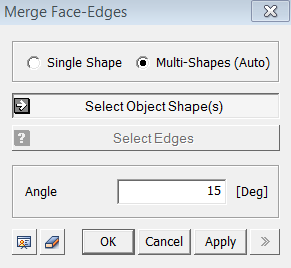Repair: Merge Face-Edges

Function
Merge Face-Edge merges separated edges of faces into single edges while maintaining the faces.
Call
Geometry > Repair > Merge Face-Edge

<Merge Face-Edge>
Select Object Shape
Select a Face on which the Merge Face-Edge operation will be executed.
Select Edges
Select edges to be merged. The selected edges must be connected to one another. Only edges of the previously selected face can be selected.
Angle Criterion
The Merge operation can be executed only when angles formed by the selected edges fall within the range of an Angle Criterion. Specify the Angle Criterion.
Notes
In the case of a degenerated edge (zero length), which exists at an apex (of a revolved shape), Merge Face Edge can not be performed. Degenerated edges are not common, but encountered from time to time during a modeling process. In such a case, mesh is generated first, and bad quality elements are modified manually through operations such as Move Node.
If Merge Face Edge is carried out for each face at a time, and then Sew operations are performed, merged edges may become disconnected again due to adjacent faces. This can be prevented only if the edges of the adjacent faces are merged and subsequently sewed. Alternatively, the edges can be sewed first and merged subsequently. In a large shell model, Sew and Merge Face Edge should be appropriately used in tandem. Using Merge Face Edge alone may reduce the speed substantially.
The start and end points of the edges, which can be merged, are displayed as red circles and blue dots respectively.